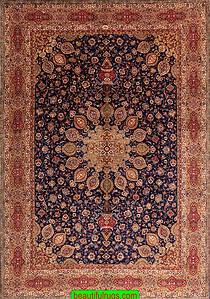Persian Rugs, History of Persian Rugs
Handmade wool rugs have become synonymous with Persian rugs because during the reign of Abbas I (1587–1629), also known as the Great, the most impressive and spectacular handmade rugs ever seen were woven.

They were designed to become part of the inner décor of the many public buildings and mosques built at the initiative of Shah Abbas or for export. Never before had such large, handmade rugs with intricate, curvilinear patterns and high knot density been woven.
Still, under Shah Abbas, skilled and professional rug weavers in state-sponsored workshops were able to create Persian rugs that became renowned throughout the world as a highly valued and treasured commodity, suitable for a palace gift from the state. Approximately 300 of these handmade Persian rugs, crafted during the long reign of Shah Abbas, have survived.
These Persian rugs were crafted with the finest silk and wool available at the time, and many can be found in museums. The so-called Salting rugs from this time still inspire and impress viewers with their brilliant, deep, and rich colors. Gold and silver threads are woven into the profusion of fine, intricate, and curvilinear arabesque details of these rugs, with the main border featuring inscriptions.
The term Safavid (or Sefavid) rugs refers to any rugs made during the reign of the Safavid dynasty from 1502 to 1722. These rugs, already renowned for their exceptional rug-weaving skills and knowledge, which were evident even before the rule of Shah Abbas I, provided a foundation for succeeding Persian rug weavers to refine and build upon.
The period from 1500 to 1700 is also called the first golden age of Persian carpets. An Ardabil carpet, dating from approximately 1520, is one such example that is periodically displayed at the museum where it is housed. https://collections.lacma.org/node/230372 An example of an Ardabil-style rug is available at Beautiful Rugs (catalog number 2210), which is based on the design of Safavid Ardabil rugs from the fifteenth century

The earliest known Persian rug that has been found dates to the seventh century CE, and it is called the Fustat carpet, which features a stylized lion shown in profile. It was likely exported from Persia to Fustat, a town near present-day Cairo in Egypt.
In the past, Persian handmade rugs have also, of course, been made in villages and by nomads, and this rug production continues in the present. Such rugs are called village and nomadic rugs (as well as tribal) and often rely on simpler geometric design elements that can readily be woven on a horizontal hand or small vertical loom and have a lower knot count. Such handmade Persian rugs possess a distinctive charm and appeal that many rug lovers and collectors seek out.
It was not until the late nineteenth and early twentieth centuries that Iran again assumed a leading role in the production and export of handmade rugs, with the state supporting and fostering the production of handmade Persian rugs.
This period has become known as the second golden age of Persian carpets, as highly sought-after and expensive antique Persian rugs over 100 years old originate from this era. Iran remains the world’s biggest exporter of rugs, and the largest, most labor-intensive, and most expensive rugs have been woven in Iran in recent years.
An example of such a magnificent handmade Persian rug is available at Beautiful Rugs (catalog number 2444) at the top of this blog entry. This rug, designed by the Isfahan master weaver Fatehi, measures thirteen and a half by ten feet. Its complex, curvilinear Gonbadi design with arabesques filling in the remaining field and main border offers a stunning example of a handmade Persian rug that relies on traditional design elements.